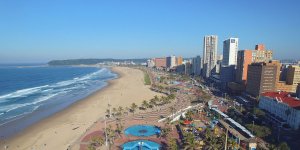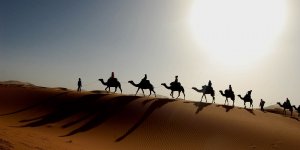Ashram, Monasteries
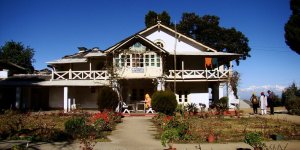
Advaita Ashrama, Mayavati, is a branch of the Ramakrishna Math, founded on 19 March 1899 at the behest of Vivekananda. »
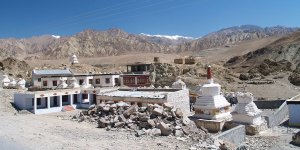
Gelug Tradition, 11th century.
Alchi Monastery or Alchi Gompa is a Buddhist monastic complex of temples in Alchi village in the Leh District of the Ladakh Union Territory. It is administered by the Likir Monastery. »
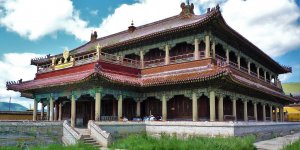
Amarbayasgalant Monastery "Monastery of Tranquil Felicity", is one of the three largest Buddhist monastic centers in Mongolia. »

Mahayana Tradition, 20th century.
Bomdila Monastery dates to the year 1965. It owes its inception to the 12th reincarnate of Tsona Gontse Rinpoche, who built the monastery before his death in the year 1966. It is a replica of the Tsona Gontse monastery at Tsona in the southern Tibet. »

Gelug Tradition, 14th century, about 100 monks.
Diskit Monastery is the oldest and largest Buddhist monastery (gompa) in the Nubra Valley of Ladakh, northern India. It belongs to the Gelugpa (Yellow Hat) sect of Tibetan Buddhism and it is a branch of Thiksay monastery. »

Nyingma Mindroling Lineage, 17th century, one monk.
Dubde Monastery, also called Dubdi or Yuksom Monastery, is a Buddhist monastery of the Nyingma tradition, Mindroling lineage. »

Nyingma Tradition, 19th century, about 90 monks.
The Enchey Sangag Rabtenling Monastery or simply Enchey Monastery is located near Gangtok, the capital city of Sikkim. It belongs to the Nyingma order of Vajrayana Buddhism. »

Fahr Monastery, (Kloster Fahr) is a Benedictine monastery of nuns located in the Swiss municipality of Würenlos in the canton of Aargau. »

Nyingma Tradition, 17th century.
Gangteng Monastery, generally known as Gangtey Gonpa, is one of the main seats of the religious tradition based on Pema Lingpa's revelations and one of the two main centers of the Nyingma school of Buddhism in Bhutan. »

Drukpa Kagyu Lineage, 17th century, about 1000 monks.
Hemis Monastery is considered to have existed before the 11th century and to be connected with Naropa, the disciple of the yogi Tilopa, and teacher of Marpa Lotsawa. It is believed that Naropa and yogi Tilopa met at Hemis. »

Gelug Tradition, 11th century, about 150 monks.
Karsha Monastery or Karsha Gompa is a Buddhist monastery in the Padum Valley of the Zanskar region of the union territory of Ladakh in northern India. It is also known by the name "Karsha Chamspaling.” »

Gelug Tradition, 11th century, about 350 monks.
Kye Gompa is a Tibetan Buddhist monastery of the Gelug tradition. It is the largest and oldest monastery of the Spiti Valley and a religious training centre for lamas. »

Gelug Tradition, 20th century, 380 monks and 360 nuns.
Kopan Monastery is a Tibetan Buddhist monastery near Boudhanath, Nepal. It is a member of the Foundation for the Preservation of the Mahayana Tradition, an international network of Gelug dharma centers. »

Drukpa Lineage, 19th century, about 70 monks.
Korzok is a Tibetan Buddhist monastery of the Drukpa Lineage, located in Korzok village, on the northwestern bank of Tso Moriri lake in Leh District, Ladakh, India, at 4,560 meters altitude. Its original name is Thupstan Sningpo Druprgout Standar Chosling. »

Drikung Kagyu Lineage, 11th century, about 150 monks.
Lamayuru Monastery is affiliated with the Drikung Kagyu school of Buddhism and houses approximately 150 Buddhist monks. The monastery is made up of several shrines and has a very rich collection of thankas and magnificent wall paintings. »

Gelug Tradition, 11th century, about 120 monks.
Likir Monastery, also known as Likir Gompa, is of the Gelugpa sect of Tibetan Buddhism. Likir means "Naga encircled." The monastery got its name as it is believed two serpent spirits, Nanda and Taksako guard it. »

Sakya Tradition, 15th century.
Matho Monastery, or Matho Gonpa or Mangtro Monastery or Mangtro Gonpa, is a Tibetan Buddhist monastery located near Thiksay Monastery. »

Nyingma Tradition, 17th century, about 300 monks.
Mindrolling Monastery is one of the "Six Mother Monasteries" of the Nyingma school in Tibet. Mindrolling Monastery is 32Km from Dehradun Airport and several direct flights are available from New Delhi to Dehradun. »

Nyingma Tradition, 16th century, about 200 monks.
Namgyal Monastery, also known as Namgyal Tantric College is the personal monastery of His Holiness the Dalai Lama. »

Karma Kagyu Lineage, 12th century, about 800 monks.
Palpung Monastery is the name of the congregation of monasteries and centers of the Chamgon Kenting Tai Situpa, one of the oldest lineages of reincarnated lamas in the Kagyu school of Tibetan Buddhism. »
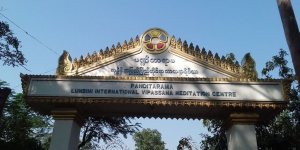
Theravada Tradition, 20th Century.
Panditarama Lumbini International Vipassana Meditation Center is located in Lumbini, the birthplace of the Buddha and one of the four main places of pilgrimage for Buddhists. »

Nyingma Tradition, 17th century, about 108 monks.
The Pemayangtse Monastery is a Buddhist monastery, near Pelling in the northeastern Sikkim, 110 km west of Gangtok. The monastery follows the Nyingma Order of Tibetan Buddhism and controls all other monasteries of that Order in Sikkim. »

Kagyu Tradition, 18th century, about 260 monks.
Phodong Monastery is a Buddhist monastery in Sikkim, India, of Kagyu Tradition. »

Gelug Tradition, 15th century, about 70 monks.
Phugtal Monastery or Phugtal Gompa is a Buddhist monastery located in the remote Lungnak Valley in south-eastern Zanskar, in the Himalayan region of Ladakh, in Northern India. It can be reached only by foot. »

Kagyu Tradition, 16th century, about 50 monks.
The monastery was the first one that introduced Jigten Sumgön’s (1143–1217), the founder of the Drikung Kagyu lineage, teachings in Ladakh. »

Mahayana Tradition, 1982, 200 resident monks and nuns.
The Plum Village Monastery is a Buddhist monastery of the Plum Village Tradition in the Dordogne, southern France. It was founded by two Vietnamese monastics, Thích Nhất Hạnh and Chân Không, in 1982. »

Karma Kagyu Tradition, 18th century, about 100 monks.
Ralang Monastery or Ralong Palchen Choling is a Buddhist monastery of the Kagyu sect of Tibetan Buddhism. »

Nyingma Tradition, 8th century.
Buddhist tradition holds that Padmasambhava was burned at Rewalsar as punishment by king Arashadhar of Mandi. When the pyre was extinguished, a lake appeared in its place with Padmasambhava seated in the middle on a lotus blossom. »

Gelug Tradition, 19th century, about 40 monks.
Rizong (or Rhizong) gompa, also called Yuma Changchubling, is a Gelugpa monastery in Ladakh, India. »

Karma Kagyu Lineage, 20th century, about 150 monks.
Rumtek Monastery is the seat-in-exile of the Gyalwang Karmapa, inaugurated in 1966 by the 16th Karmapa. The monastery is a replica of the Tsurphu Monastery, Tibet, built during the 11th century, the original seat of the previous Karmapas. »

Swami Dayananda Ashram was established in 1967 and expanded in 1982 when also received the official name Arsha Vidya Pitham. »

Nyingma, Gelug Tradition, 10th century, about 60 monks.
Founded in 996 CE by the Tibetan Buddhist lotsawa Rinchen Zangpo, on behalf of the king of western Himalayan Kingdom of Guge, Yeshe-Ö, Tabo Monastery is the oldest continuously operating Buddhist enclave in both India and the Himalayas. »

Nyingma, Kagyu Traditions, 15th century.
Paro Taktsang, also known as the Taktsang Palphug Monastery and the Tiger's Nest, is a sacred Vajrayana Himalayan Buddhist site, a spiritual and cultural icon of the kingdom of Bhutan and a popular touristic attraction. »

Nyingma Tradition, 17th century, about 70 monks.
Tashiding means "The Devoted Central Glory" and is part of Buddhist religious pilgrimage circuit starting with the first monastery at Yuksam in Sikkim known as the Dubdi Monastery, Norbugang Chorten, Pemayangtse Monastery, the Rabdentse ruins, the Sanga Choeling Monastery, and the Khecheopalri Lake. »

Gelug Tradition, 17th century, about 400 monks.
Tawang Monastery, located in Tawang city of Tawang district in the Indian state of Arunachal Pradesh, is the largest monastery in India and second largest in the world after the Potala Palace in Lhasa, Tibet »

Gelug Tradition, 20th century, about 55 monks.
Located in Kalimpong, West bengal, Gaden Tharpa Choling Monastery is a Gelugpa monastery founded by Domo Geshe Rinpoche Ngawang Kalsang in 1912. »

Gelug Tradition, 15th century, about 80 monks.
Thiksay Monastery is noted for its resemblance to the Potala Palace in Lhasa, Tibet, being also known as “Mini Potala.” »

Nyingma Tradition, 19th Century.
Tsuklakhang Palace or Tsuklakhang Royal Chapel and Monastery is a Buddhist palatial monastery in Gangtok, Sikkim, India. It served as a location for coronation, marriages, and victory ceremonies for the Sikkimese royalty until the merger of Sikkim as a state of the Indian Union in 1975. »

Gelug Tradition, 19th century, about 40 monks.
Ghoom Monastery, also known as Yiga Choeling belongs to the Gelugpa sect and is one of the oldest Tibetan monasteries in Darjeeling. It was built in 1850 by the famous Mongolian astrologer and monk Sokpo Sherab Gyatso. »

Nyingma Tradition, 20th century, about 300 monks and nuns.
Zangdokpalri Monastery is a Nyingma monastery established by Dudjom Rinpoche in Kalimpong, West Bengal, India, in 1946. The monastery is popularly known as Durpin Monastery. »



